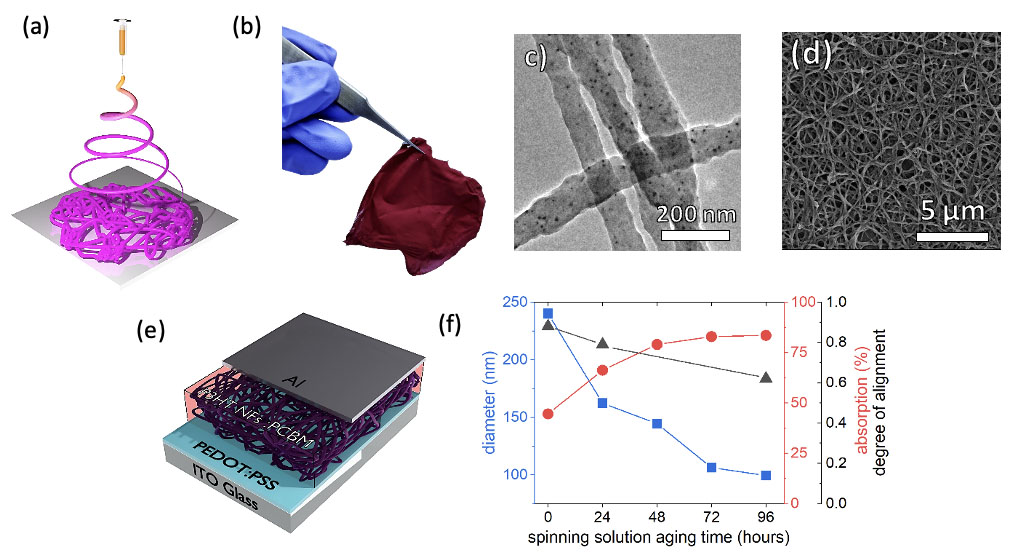| Dec 14, 2023 | |
Ultra-thin solar cell fibers usher in a new era of organic photovoltaics |
|
| (Nanowerk Spotlight) Supplying energy to an ever-increasing global population is the most pressing concern of our generation, and yet existing technologies fall short at meeting this demand whilst fulfilling net zero targets. Solar cells offer possible solutions by generating clean energy with low CO2 emissions by a low-cost device. Emerging technologies such as organic solar cells provide numerous benefits over their silicon counterparts – being cheaper, thinner, more flexible and can be printed from solution. | |
| Despite their potential, organic solar cells based upon the conventional bulk heterojunction active layer have faced challenges in competing at the efficiency levels demonstrated by other silicon or perovskite photovoltaics. | |
| Enter nanofiber-based organic solar cells. This architecture offers greater light-harvesting and charge transport, tuneability, and precise control of domain size and the distribution of the material compared to the bulk heterojunction blend. To produce this architecture, the electron donor (a polymer semiconductor) is electrospun to create a continuous nanofiber web which is subsequently infiltrated with the electron acceptor. However, in order to deliver on these advantages, the key lies in controlling the diameter of the nanofibers. | |
 |
|
| (a) Schematic of the nanofiber electrospinning and (b) digital image of a free-standing web of solar light-harvesting P3HT nanofibers. (c) Transmission and (d) scanning electron microscopy image of the nanoparticle-containing P3HT fibers and (e) depiction of the proposed nanofiber-based solar cell. (f) The link between fiber diameter, the extent of polymer chain alignment and light harvesting properties. A lower value indicates a greater degree of alignment. (Image courtesy of the researchers) | |
| Researchers at the University of Oxford's Department of Materials have pioneered a method for creating poly(3-hexylthiophene) (P3HT) nanofibers with the smallest dimensions yet reported. This was accomplished by electrospinning P3HT along with an auxiliary polymer, PEO, and incorporating innovative silver or gold nanoparticles. | |
| Due to the difficulty in electrospinning photoactive polymers including P3HT, reported nanofibers have been too thick for solar applications, in many cases thicker than the entire cell. | |
| "The diameter of the fiber is essential to its solar performance as excitons (electron-hole pair) must be formed close to the fibre surface, which becomes the interface for separation with the electron acceptor after infiltration," Professor Nicole Grobert, head of the Nanomaterials by Design research group, explains to Nanowerk. "Therefore, the diameters must be sufficiently small, else the electron and hole will recombine, quenching the potential charge carriers. At just over 50 nm in diameter after PEO removal, these fibers offer short exciton diffusion pathways to the interface for effective separation." | |
| The team reported their findings in Advanced Composites and Hybrid Materials ("Driving Fiber Diameters to the Limit: Nanoparticle-induced Diameter Reductions in Electrospun Photoactive Composite Nanofibers for Organic Photovoltaics"). | |
| The diameter reduction upon nanoparticle addition is achieved through the modulation of the electrical conductivity and viscosity of the precursor solution over time. Ryan Schofield, the paper’s first author, explains that "through nanoparticle addition, we may increase electrical conductivity of the spinning solution, whilst surprisingly disentangling the polymer, reducing viscosity. This means the forming fiber experiences greater elongation forces and less resistance to stretching, producing thinner nanofibers than previously possible". | |
| Simultaneously, the researchers were also able to control the light absorption properties as they reveal that the extent of polymer chain alignment along the fiber axis was closely linked to the fiber diameters. As halving of the diameter coincided with a two-fold increase in light-harvesting in part attributed to improved alignment. | |
| The presence of nanoparticles also provided an additional boost in light harvesting via plasmonic enhancement effects. Overall, the combination of a favoured polymer orientation and the plasmonic effects from the nanoparticles could deliver a 1.58x absorptance enhancement over their thin-film counterparts. | |
| Now producible at the appropriate size, this work presents an important milestone for realising the true potential of the nanofibrous active layer, a very promising yet previously difficult to fabricate active layer structure. | |
| Typically to increase the absorption ability photoactive polymers, new polymers will need to be engineered at the molecular level. Such chemistry is time-consuming and laborious, whereas here the enhancements are achieved solely through a change in how the polymer is processed. | |
| Further, this approach is not just applicable to P3HT, says Professor Hazel Assender head of the Polymer research group. As the mechanism is controlled by the interplay between the auxiliary polymer and nanoparticles, this strategy has the potential to be universal across a wide range of solar polymers with simple adaptation. | |
| The unrivalled diameter reduction and resultant fibers therefore present a straight-forward step-change in how photoactive polymers are electrospun – bridging the gap between fibers reported in literature and the ideal nanofiber for photovoltaic applications. | |
| With the magnitude of energy delivered by the sun dwarfs the global energy demand, with just 1 hour of sunlight equating to a year of required energy, these improvements in solar technologies are essential to combating climate change and delivering energy security. | |
 By
Michael
Berger
– Michael is author of three books by the Royal Society of Chemistry:
Nano-Society: Pushing the Boundaries of Technology,
Nanotechnology: The Future is Tiny, and
Nanoengineering: The Skills and Tools Making Technology Invisible
Copyright ©
Nanowerk LLC
By
Michael
Berger
– Michael is author of three books by the Royal Society of Chemistry:
Nano-Society: Pushing the Boundaries of Technology,
Nanotechnology: The Future is Tiny, and
Nanoengineering: The Skills and Tools Making Technology Invisible
Copyright ©
Nanowerk LLC
|
|
|
Become a Spotlight guest author! Join our large and growing group of guest contributors. Have you just published a scientific paper or have other exciting developments to share with the nanotechnology community? Here is how to publish on nanowerk.com. |
|
